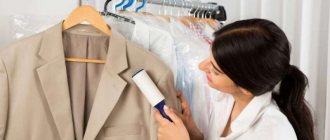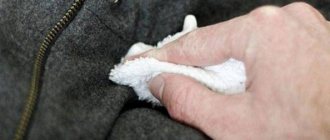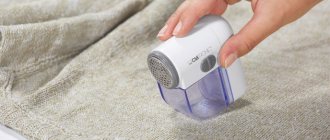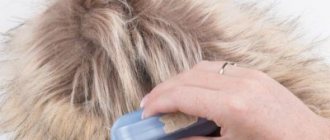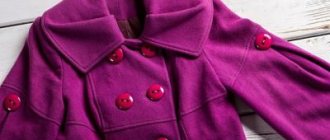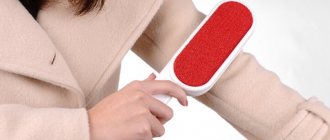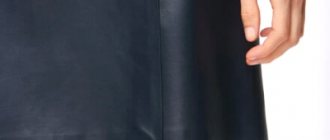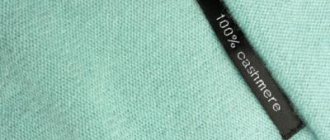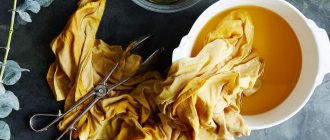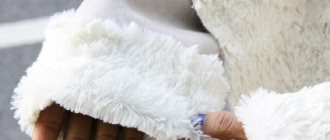A coat made of drape is popular in the autumn-winter period, as woolen fabric does not allow wind to pass through and retains heat well. In order to preserve the presentation of outerwear for as long as possible and extend its service life for more than a year, drape fabric needs proper care.
Over time, any thing gets dirty. Many people dry clean their clothes to avoid unnecessary problems. This option is the most effective and safe. However, if it is not possible to take your coat for professional cleaning, many people are faced with the problem of how to properly wash any clothing at home.
Properties of drape
Drape is a dense woolen fabric with a complex fiber weave structure. It has high heat-insulating properties. This material does not wear out for a long time, maintaining the original shape of the product made from it.
Drape fabric consists of two layers. For the upper part of the material, wool is taken, while the bottom layer can be a mixture, with the addition of cotton or linen fibers. In some cases, a certain type of impregnation is used for drape, achieving increased strength and smoothness. Often, the seams and joints of a finished coat are additionally treated with glue in order to prevent their divergence.
You should pay attention to these nuances when choosing a method for cleaning your favorite item. For example, the adhesive may not withstand machine washing. A coat made of low-quality fabric can shrink in the machine and fade. Therefore, be attentive to the manufacturer's recommendations for washing the product.
Features of drying and ironing at home
It will not be possible to put a drape coat in order without drying it. After washing, the product made from drape fabric must be allowed to drain.
Drape products cannot be twisted! Firstly, it’s not so easy to do, and secondly, it can become very wrinkled, and putting it in order later will not be an easy task.
On hangers, the product will dry quickly and there will be no wrinkles on it. But you shouldn’t hang up your coat immediately after washing, because when wet its weight is significant. You should not dry it near heat sources, because it may shrink.
If you dry it properly, there will be no need to iron it. You can use a steamer and the product is ready for further use.
Ways to wash a drape coat
Before you begin the cleaning process, you need to find a label on the coat that contains information about a possible method of caring for the product. 4 possible options for cleaning a drape coat:
- dry method;
- wet processing of the product, without soaking;
- handwash;
- Machine washable.
These methods are arranged in order of preference, i.e. with dry cleaning, the risk of damage to the drape coat is minimal. In other cases, you should strictly follow the recommendations for caring for the product. This is the only way the coat will retain its presentable appearance.
How to stroke?
Before ironing your coat, read the label information. Set the iron to the desired temperature. When ironing a drape coat, it is best to use the steam function. If your device does not provide it, then it can be replaced by ironing the product through a damp natural fabric, for example, chintz or gauze, folded in several layers.
Try to clean your drape coat every time before storing it after the end of the cold season. This will help you prevent damage to the product by moths. To repel moths, you can additionally use special means.
We hope that our tips will help you cope with such a task as washing a drape coat. Try to follow the directions on the product label so that the item will last longer and you won’t have to throw it away after one or two seasons.
For more tips on how to properly care for your coat, watch the following video.
Dry cleaning of drape coats
This method is suitable when washing is prohibited. The cleaning process for the product goes like this:
- The coat is carefully patted, knocking out dust, removing pieces of wool and dried dirt.
- Next, take a vacuum cleaner with a furniture or fabric attachment and clean the coat.
- Remove the pellets, preferably not with your hands, but with a special machine.
- Inspect the coat from all sides, paying special attention to frequently dirty parts: pocket openings, sleeve folds, collar.
- Greasy areas and greasy stains are sprinkled with an even layer of talcum powder or starch and left to act for several hours. Cleaning agent that has absorbed grease is removed using a soft brush. Copes well with the shine on drapery fabric and the crumb of black bread. They simply wipe the shiny area with it, and the shine disappears.
You can remove a greasy stain from a coat by covering the stain with a paper napkin and gently ironing it with a hot iron. The paper will absorb all the grease.
Wet processing of the product, or washing without soaking
If the manufacturer allows partial or hand washing, then a drape coat can be cleaned by wet processing. This is done like this:
- Prepare a cleaning solution, the water should be warm. For the solution, you can use soap or a special detergent for woolen products.
- Using a sponge, apply the solution to the surface of the coat; contaminated areas can be cleaned with a soft brush.
- Prepare a bowl of cool water. Once the stains are gone, use a clean soft cloth to wipe the coat, as if collecting and rinsing off the cleaning product. This “rinsing” should be carried out with the utmost care, otherwise, after the clothes dry, streaks may appear.
- Lay the coat out on a flat surface and blot off excess moisture with a towel.
- Leave the coat on hangers to dry naturally. Avoid exposure to sunlight and heating devices.
How to wash a coat in a washing machine
First of all, find out the composition of the fabric of your coat. Only polyester is safe to machine wash. All other materials run the risk of irreversibly losing their appearance during machine washing.
- In the machine settings, set the mode for delicate fabrics: temperature 40 degrees, “delicate wash” or “hand wash”, turn off the spin cycle.
- It is recommended to place the coat in a special washing bag.
- Fasten all fasteners except buttons.
- Pour washing conditioner into the special compartment.
- After finishing washing, leave the coat to dry in a well-ventilated place.
Unforeseen circumstances or seasonal care make you wonder whether you can wash your coat at home. The question arises: is it possible to wash it at all? It is possible, but the method: manual, machine or dry cleaning directly depends on the composition.
It is allowed to wash coats in an automatic washing machine if they are made from the following materials:
- acrylic (PAN);
- Lycra (LY);
- modified acrylic (MA);
- nylon (NY);
- polyamide(PA);
- polyurethane fiber (PU);
- polyester (PL);
- elastane (EL).
Delicate dry cleaning is allowed for any type. Washing coats in an automatic machine is not possible for all products. If the fabric type is mixed, you should pay attention to the presence of natural fibers. Plant and animal components complicate the care of the coat.
Please check the label before washing. In the picture on the left - the coat can be washed on a delicate cycle at a temperature of no more than 40 ° C, on the right - only delicate dry cleaning is allowed.
It will not be possible to wash a coat at home using an automatic machine if it consists of 100% natural fibers, for example, cashmere (WS 100%), drape, wool. Neither delicate mode, nor minimum temperatures, nor special means will help. This is because, in addition to natural fibers, a cashmere coat has a special impregnation.
Dublerin is responsible for maintaining its shape, but upon contact with water and temperatures it is washed out. The appearance of a washed coat changes dramatically: the hems and collar are rolled up, the fabric looks wrinkled.
Natural fibers combined with synthetic ones give a mixed composition. If the synthetic content is about 50%, then feel free to start washing.
How to wash a coat in a washing machine.
If the label located on the product and the composition are machine washable, feel free to proceed. Don’t forget about the general washing rules: preparation, mode, temperature, spin.
Preparing for washing
Elements that may harm the appearance of the coat when washed should be removed. If they don’t come unfastened, then they unfasten if possible. Elements for removal include: three-dimensional decorations, jewelry, metal parts, collars, cuffs. The buttons are fastened.
Preparation involves not only removing cuffs and fur collars, but also cleaning the material. Pre-cleaning involves removing aggressive contaminants: dust, surface stains, soil and sand. Animal hair and threads should also be removed from the coat material.
For cleaning, you should use a special brush with medium-hard bristles or a roller to comb the product along the seams. If there are none, use a dish sponge with a rough coating. The product must be cleaned first with dry and then with soft, wet cleaning.
It is convenient to carry out the procedure on a horizontal surface, which will further avoid deformation of the product.
List of available modes for washing coats:
- For all types of fabrics, even finicky ones: delicate; manual; wool.
- For polyester, padding polyester, membrane: synthetic; membrane.
- For coats filled with down and feathers: a duvet.
The correct washing mode is the key to the safety of the product. Information about acceptable modes can also be found on the label.
The range from 30 to 40 degrees is typical for many fabrics, both artificial and natural. These include wool coats with the addition of gabardine and vigoni.
A level of up to 30 degrees will have to be maintained if the coat is made of tweed, suede, polyester, or neoprene.
No twisting, just gentle hand squeezing. Automatic spinning is not recommended for any type of fabric or filling. Application is fraught with deformation for the material and breaking into lumps for padding polyester.
The spinning and drying cycles should take place outside the drum. Natural removal of moisture by draining water is an ideal spinning method. To speed up the process, you can blot your coat with dry towels.
The exception is products made from holofiber. They can be dried at 1 thousand revolutions.
Handwash
You can wash it by hand if there is a special permission icon on the clothing label. Follow these steps:
- Fill the bath with cool water, no higher than 30 °C, and add detergent for the care of woolen items. Place the coat in the water and gently press on it until the material is completely wet. You cannot rub a product made of drape, so only kneading movements or careful cleaning of particularly dirty areas with a brush are permissible. To enhance the effect, you can leave the product to soak for 30 minutes.
- The next step involves rinsing in clean water until all the soapy water is removed. As an option, place the coat on hangers, hang it up and rinse with water from the shower. You cannot wring out a drape item, so leave the coat over the bathtub until all the water has drained.
- You can dry it in 2 ways: by spreading the coat on a terry towel, straightening out all the folds; hung on hangers.
Selecting a detergent
Regardless of whether a drape coat can be washed in a washing machine or is only allowed to be washed by hand, it is recommended to use detergents that rinse well and do not leave streaks on clothes. The choice should be made on liquid products such as gels and capsules. It is advisable to choose products in accordance with the color of things: for colored, for white, for black.
Attention! Do not use detergents that contain chlorine or active oxygen.
Machine washable
In most cases, machine washing is not recommended. And yet, if you decide on this method of washing, then follow these tips:
- Choose a wool washing program or a delicate cycle.
- Set the water temperature to no more than 30 °C.
- Use wool powder. Avoid using conditioners and other additives.
- Turn off the spin and dry function.
- Remove the coat from the machine and leave it on hangers until completely dry. Don't forget to straighten out the folds and straighten the hood.
(votes: 1, average: 5.00 out of 5)
How to dry properly
To get rid of excess water, you can lay your coat in the bathtub, apply pressure with your palm and run it from the collar to the bottom of the item, pushing out the water. A large terry towel will help dry the item of clothing a little more. You need to wrap the item and leave it for a while so that the towel absorbs the moisture. Next, take a towel or other highly absorbent fabric, on which the coat is placed to dry. If possible, the drying room should be well ventilated. The sun's rays are also an undesirable phenomenon, as are heating devices.
